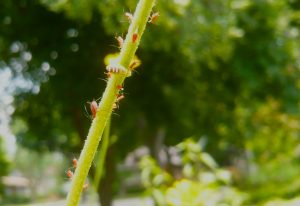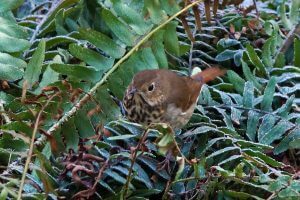5 Reasons Why Edible Gardens Need Native Plants
We often get asked if it’s ok to grow natives with edibles, and the answer is yes, as that’s what many of us native gardeners have been implementing with great success. In fact, on a larger scale, many farmers are beginning to experiment with incorporating insectaries or prairie strips mostly filled with native plants as part of their farming practices. With these strips, farmers find:
- They need to use less pesticides;
- Crops are more productive;
- Less soil erosion;
- Improved water quality.
Why? Here are the reasons:
1. A native plant hedgerow or garden will maintain a steady population of beneficial insects. These insects don’t care if their prey is on an edible plant or on an aster. Native plants support many different kinds of herbivorous insects, which in turn attract natural enemies, such as predatory and parasitic wasps, birds, ladybugs, beetles (many species of larvae are voracious ground predators consuming root pests), lacewings, ambush bugs, etc. By having these insects in your garden from the very beginning and giving them a steady supply of food and resources, when your plant crops are getting planted and in full swing, your pest control is already in place. Let’s not forget that birds eat insects, and having a bird-friendly garden will encourage them to help control pests. Many birds love slugs, as do many beneficial soil organisms such as Firefly larvae.

2. Native plants attract pollinators, particularly native bees. You should have plants blooming in the early spring through fall because pollinators are active then, and they all have differing times of emergence which will overlap with your flowering vegetable plants (such as tomatoes, squash, etc). Native bees are more efficient pollinators than honeybees; honeybees negatively impact native bees. Having native plants present means you support native bees that have specialist relationships with native plants. Some bees can only use the pollen from the Helianthus genus to feed their larvae. Squash bees are a native bee and the best pollinator for squash. When these populations are not supported, people often either do not get squash (zucchini, etc), or they must hand-pollinate to ensure squash producing plants.
3. With a native garden, it’s best to do minimal maintenance in the fall and spring which will ensure beneficial insects overwinter and emerge with healthy population levels in the spring. Vegetable gardens often need to be cultivated and plant material removed, which can destroy beneficials, as well as pests (although that practice is changing as long as plants were disease-free). Having a section of natives acting as a refuge can help to mitigate the impact of edible garden clean-up on your beneficial populations. Undisturbed areas also provide nesting and

overwintering sites for the native bees. Many of our solitary native bees nest in the ground (they are no threat to you, unlike Yellow Jackets) or in cavities or stems. Having your native plant garden act as a refuge is immensely critical to pollinator and pest control services.

4. If your native hedgerow is near your edible garden, or if you interplant native plants, you can also improve the soil by increasing soil biodiversity, and adding organic matter, which increases water holding capacity. Many native plants have extensive roots systems that tend to go downward 10+ feet, and every year, some of those roots die back, adding organic matter. The roots also penetrate down into the soil creating water channels; the more organic matter you have, the more water holding capacity of your soil, which means for you, less extra irrigation. Some native plants also are nitrogen fixers, and also attract pollinators. Partridge Pea is one of those plants, one of our few annuals, and of short stature.
5. Many native plants are edible. (Though do your research about what parts are edible and how to prepare them). Prior to colonization and genocide against Indigenous people in the U.S., native plants were (and still are) food and medicine. Indigenous people were farming and managing land well before and in a more sustainable manner than white settlers.
Below is a list of plants that will be available at our plant sale, so it is not exhaustive. To assemble the list below we used: Plants for a Future.
Allium cernuum – Nodding Wild Onion – bulbs, leaves (like chives, gave Chicago its name)
Amorpha canescens – Lead Plant, a nitrogen-fixer
Aquilegia canadensis – Columbine, flowers edible (but leave some for hummingbirds)
Asarum canadense – Wild Ginger – roots
Blephilia ciliata – Downy Wood Mint (weak mint tea)
Camassia scilloides – Wild Hyacinth – bulb
Dalea purpurea – Purple Prairie Clover, dried leaves, tea
Eupatorium purpureum – Sweet Joe Pye Weed, roots ashes used as a salt
Hydrophyllum virginianium – Virginia Waterleaf – leaves
Monarda fistulosa – Wild Bergamot – tea, leaves
Opuntia humifusa – Prickly Pear Cactus – leaves pads and fruit (remove spines)
Podophyllum peltatum – May Apple – only the fruit when ripe; all else poisonous
Polygonatum biflorum – Solomon’s , roots and young shoots boiled or cooked (berries, seeds poisonous)
Sisyrinchium angustifolium – Blue-eyed Grass, leaves,cooked
Zizia aurea – Golden Alexander – flowers added to salad or cooked like broccoli
